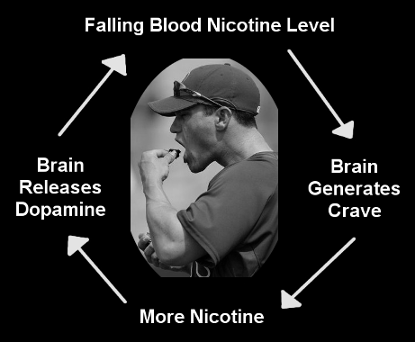Whether a closet user who hides their addiction, a low tolerance level addict whose twice-daily use has them denying it, or a heavy and open addict like I was, our dependency infected far more of life than we care or cared to admit.

Once we permit ourselves to begin looking closely, it becomes hard to find any aspect of life that wasn't, to some degree, touched by our addiction.
Our endless feeding cycle was a perpetual interruption. Aside from the time devoted to using, there was non-stop use planning, the need to re-supply, clean-up, and return to the activity use had previously interrupted, or to a new one.
As smokers or e-cigarette users, how many times daily did we suck 1 milligram of nicotine into our lungs? As snuff users, how many times did a 2.5-gram pinch stay in your mouth until generating 3.6 milligrams of pure nicotine juice? If a chewer, how many times daily was 7.9 grams of loose tobacco jawed until it let go of 4.5 milligrams of tissue penetrating nicotine?[1]
And then we'd wait for nicotine's two-hour elimination half-life and a falling tonic dopamine level to command us to use again. Or we could accelerate nicotine elimination by encountering stress, drinking alcohol, or consuming vitamin C.[2]
Nicotine's presence altered our body's natural sensitivities. It destroyed our ability to relax, hijacked our priorities, and consumed precious time.
Smoking it diminished lung function while gradually destroying our bloodstream's ability to receive and transport life-giving oxygen. Altered vaping sensitivities include living with chronic dry mouth and dehydration, sore throats, a now and then flavoring reaction, or even tinnitus (ear ringing) or headaches.
Whether smoked, chewed or sucked, tobacco diminished the accuracy of our smell and taste, while making us home to smoke's more than 4,000 chemicals or oral tobacco's more than 2,550.[3] If a smoker, we introduced up to 81 cancer-causing chemicals[4]. If an oral tobacco user, up to 28 [5].
And e-cig users need to remain mindful not only about the impurities in untested juice but about the possibility of their mod's vaporizing coil getting so hot that it begins generating the carcinogens formaldehyde and aldehyde.[6]
Like a mouse on an exercise wheel, there's no end to this endless cycle of madness unless we get off, unless nicotine's arrival ends.
Forgotten Relaxation
Two million years of evolution prepared us to fight or flee the now extinct saber tooth tiger. Our body's response to sensing danger or sudden stress is activation of the "fight or flight" pathways of the sympathetic nervous system. Nicotine also activates these pathways.[7]
Nicotine's arrival in the brain causes the release of noradrenaline (nor-epinephrine), which in turn causes more than 100 neuro-chemicals to prepare the body to run for its life or fight.
Is it normal to spend the balance of life under the influence of an adrenaline releasing central nervous system stimulant?

Before climbing into bed to sleep, is it normal to consume a chemical that will make our heart pound up to 17.5 beats per minute faster,[8] that elevates blood pressure, restricts extremity blood flow causing the temperature of our fingers to drop up to seven degrees,[9] that accelerates breathing, dilates our pupils, perks our senses, shuts down digestion, and that triggers the release of glucose and fats from our body's energy stores?
As active addicts, most of us claimed that nicotine helped us relax. But activating our fight or flight response shows just how neurochemically confused we became about nicotine's impact upon us.
Try to imagine what it would be like to go hours or an entire day without once having adrenaline pumped into your bloodstream.
What would it feel like to stop endlessly beating yourself as if whipping a tired horse, to stop responding to non-existent saber tooth tigers, to again know and bask in full, deep and complete relaxation for extended periods of time?
Forgotten Calm During Crisis
Have you ever noticed what you reach for during crisis? That's right - as just reviewed - a nervous system stimulant that activates the body's fight or flight response.
 While stressful situations can by themselves activate our body's fight or flight response, why guarantee that it happens? When confronted with stress, why intentionally make your heart pound faster, elevate your blood pressure, and induce extra anxiety?
While stressful situations can by themselves activate our body's fight or flight response, why guarantee that it happens? When confronted with stress, why intentionally make your heart pound faster, elevate your blood pressure, and induce extra anxiety?
Even more disturbing, intentionally adding the body's fight or flight response to every stressful situation was nothing compared to the reason why we reached for nicotine during crisis, because stress accelerated removal of nicotine from our bloodstream, causing the onset of early withdrawal.
We'll review how stressful situations threw us into withdrawal in the next chapter (Use Rationalizations) under the heading "Use relieves stress and anxiety."
Here, simply ask yourself this. What would life's stressful situations be like if the anxieties of early nicotine withdrawal were never again added to them, resulting in fewer situations activating the body's fight or flight response?
Imagine being far calmer during crisis. What would it be like to again be you?
References:
2. Spitzer, J, Never Take Another Puff, WhyQuit.com, 2003.
3. U.S. Surgeon General, Reducing the Health Consequences of Smoking: 25 Years of Progress: A Report of the Surgeon General: 1989, Page 79.
4. Smith CJ et al, IARC carcinogens reported in cigarette mainstream smoke and their calculated log P values, Food and Chemical Toxicology, June 2003, Volume 41(6), Pages 807-817.
5. IARC Monographs on the Evaluation of Carcinogenic Risks to Humans, Smokeless Tobacco and Some Tobacco-specific N-Nitrosamines, 2007, Volume 89.
6. Farsalinos KE et al, E-cigarettes generate high levels of aldehydes only in 'dry puff' conditions. Addiction. 2015, Volume 110(8), Pages 1352-1356. doi:10.1111/add.12942.
7. Haass M, et al, Nicotine and sympathetic neurotransmission, Cardiovascular Drugs and Therapy, January 1997, Volume 10(6), Pages 657-665.
8. Parrott AC et al, Nicotine chewing gum (2 mg, 4 mg) and cigarette smoking: comparative effects upon vigilance and heart rate, Psychopharmacology (Berlin). 1989, Volume 97(2), Pages 257-261 (2 mg gum average increase of 5 beats per minute [bpm], 4 mg gum 10 bpm, smoking nicotine 17.5 bpm) Houlihan ME, et al, A double blind study of the effects of smoking on heart rate: is there tachyphylaxis? Psychopharmacology (Berlin), May 1999 Volume 144(1), Pages 38-44 (max increase of 15 bpm); also, Najem B, et al, Acute cardiovascular and sympathetic effects of nicotine replacement therapy, Hypertension, June 2006, Volume 47(6), Pages 1162-1167 (average increase of 7 bpm).
9. Lorillard Tobacco Company, Nicotine and sympathetic neurotransmission, 1949-1955, http://tobaccodocuments.org/lor/95309579-9589.html
All rights reserved
Published in the USA
